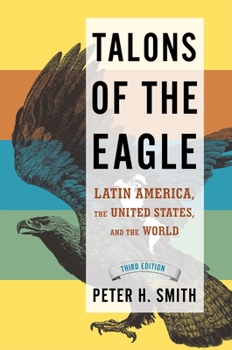Talons of the Eagle: Latin America, the United States, and the World
Select Format
Select Condition 
Book Overview
After the terrorist attacks of September 11, 2001, a new international regime emerged and profoundly transformed inter-American affairs. In the third edition of Talons of the Eagle: Latin America, the United States, and the World, Peter H. Smith places this devastating event into its full historical context by offering a vivid portrayal of U.S.-Latin American relations from the early nineteenth century to the present. A new section, "The War on Terror," examines the impact of 9/11 on the United States and Latin America, with a focus on George W. Bush's Latin American policy. Smith also analyzes Latin American reactions and responses to the U.S.--and to the rest of the world--in these complex and troubling times. Throughout, this provocative text casts new light on such contemporary issues as economic integration, drug trafficking, undocumented migration, and the rise of Latin America's "new left." Rather than concentrating solely on U.S. policy, Smith addresses the structural relationships between the two regions by focusing on international systems, the distribution of power, and the perception and pursuit of national interests. Designed explicitly for classroom use, this new edition integrates photographs, political cartoons, charts, and tables directly into the text. To further enliven the subject, anecdotal sidebars highlight such incendiary and discussion-worthy topics as the origins of anti-imperialist sentiment in Latin America, Che Guevara's hopes for continental revolution, Ronald Reagan's denunciation of communist threats in Central America, George W. Bush's justifications for the war in Iraq, and Hugo Ch z's anti-Bush remarks at the United Nations. Deftly researched and thoughtfully composed, this text is ideal for general courses in Latin American history and politics as well as courses in U.S. foreign policy and inter-American relations. Timely and topical, Talons of the Eagle, Third Edition, presents an eminent scholar's perspective on the interaction between global trends and inter-American affairs--a subject that has become crucially important in our recent history.
Format:Paperback
Language:English
ISBN:0195320484
ISBN13:9780195320480
Release Date:December 2007
Publisher:Oxford University Press
Length:448 Pages
Weight:1.42 lbs.
Dimensions:6.1" x 0.9" x 9.1"
Customer Reviews
3 ratings
Excellent, meaningful read.
Published by Thriftbooks.com User , 15 years ago
I read this book last semester for US-Latin American history class, and it is one of the few that I was proud not to resell. The book was extremely interesting and well-written, and the author did an impressive job of relating US-Latin American relations to world events outside of the region. Most importantly, the author connected each historical event to a greater, big-picture theme in history, commenting on its significance and relevance. Although I have previous knowledge of US-Latin American relations, I still learned a lot by reading this book. Even if you have no experience studying US or Latin American history, it is a worthwhile read. I'd highly recommend this book to anyone interested in any field of history.
Very solid analysis
Published by Thriftbooks.com User , 18 years ago
Very good analysis. Well written. An excellent read whether you are a beginner or somewhat versed in LatAm and US relations. It serves as a great review of history as well.
First rate interdisciplinary approach to history.
Published by Thriftbooks.com User , 27 years ago
In this very readable historiacl survey of U.S.-Latin American realations, Smith develops a template which demonstrates the logic of U.S. policy and Latin American response within the context of the global situation. To accomplish this, he breaks history into three general time periods: 1790s-Cold War, The Cold War, and the post-Cold War. In each of these periods, Smith develops the global context or "rules of the game", then moves on to the resulting U.S. policy. He finishes each historical era with an incisive analysis of Latin American options for response. This book is a must for students of Latin America and certainly for those individuals whose activities, whether they be commercial or official in nature, are shaping the book's next chapter.






